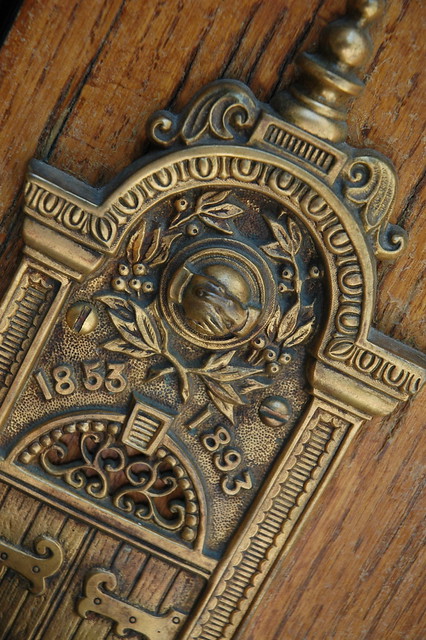A few days ago I was looking over the interior photos of the Kansas City Missouri Temple that are currently posted on The Church of Jesus Christ of Latter-fay Saint's newsroom website. The photos are very nice and I encourage you to view them. One repeated element of this temple is olive branches. There are olive branches in the exterior precast panels, carved into art glass, added to custom railings and light fixtures, sculpted into carpets, gold leafed onto walls, and painted in the temple. A large stained glass window of an olive tree stands behind the recommend desk, flanked by olive branches sculpted into the adjacent panes. The furniture in the temple also features olive branches (the sealing room sealer's desk is covered in olive branches). There are also bowls in the celestial room with olive branches on them. Olive branches are the unifying symbol in this temple. I want to take a little time to discuss how olive branches are used in temple architecture and how they are an appropriate symbol.
I thought that olive branches had been used a lot in temple architecture, but discovered very few examples of their use. I suspect (and hope) that I have missed a few places where they are used.
 The Winter Quarters Nebraska Temple contains various temple symbols. In the baptistry there are three panes with sculpted glass. They are a fig branch, an almond branch, and an olive branch (left). All 3 are symbolic. The Winter Quarters Nebraska Temple also has olive branches on the front doors. You can see these in the photo on the right.
The Winter Quarters Nebraska Temple contains various temple symbols. In the baptistry there are three panes with sculpted glass. They are a fig branch, an almond branch, and an olive branch (left). All 3 are symbolic. The Winter Quarters Nebraska Temple also has olive branches on the front doors. You can see these in the photo on the right.
The Salt Lake Temple also has olive branches. The front doors have olive branches on the metal plate behind the doorknob seen in the picture below. You can see the original of this photo here.
Olive branches and trees make an excellent temple symbol. Olives represent peace. They are a symbol of God's covenants with man (a dove brought an olive branch to Noah showing that the flood was over). Olive oil is used in priesthood ordinances and so olives are a symbol of the priesthood and Christ. Olive oil can provide light and olives symbolize light. Olive trees represent Israel, God's chosen people, and all mankind (see Jacob 5 in The Book of Mormon where the tame olive tree represents Israel and the wild olive tree represents everyone else and God is concerned about saving both). Olive oil is also a symbol of royalty and was used to anoint kings and priests.
In the temple, olives signify that temple work is done by the priesthood, concerns all of humanity, brings us peace and heals us. It establishes the government of God. Olives are indeed a great temple symbol.
I like how extensively the olive symbol was used in the Kansas City Missouri Temple and hope that olives, olive branches, and olive trees will continue to be used in temple architecture. I also find olives fitting for Kansas City. The temple is a 5 minute drive from Liberty Jail in Missouri where the prophet Joseph Smith and others were imprisoned for a time. It is in a state where a lot of violence, murders, etc. were done against The Church of Jesus Christ of Latter-day Saints and where Latter-day Saints were driven from the state. The olive branch helps show that this tragic past has been overcome and points to the fact that we believe that Jesus Christ will come to Missouri as a part of his second coming and that Zion, the New Jerusalem will be built not far from here in Independence, Missouri. The peace of the gospel and the Millenial reign of Jesus Christ will more than overcome the past.
Those are my thoughts. Please write and let us know what you think and particularly where else olives are used in temples.

